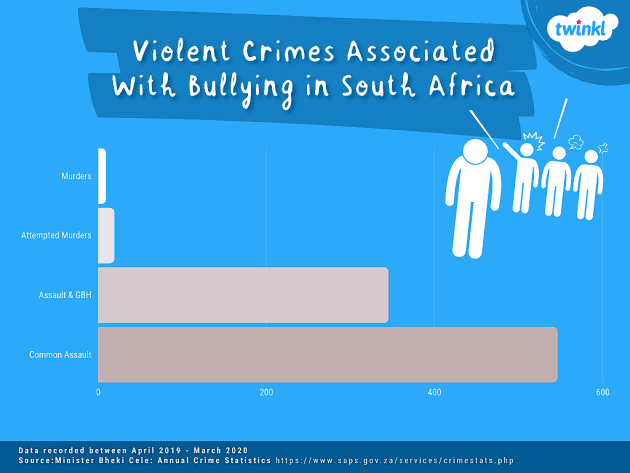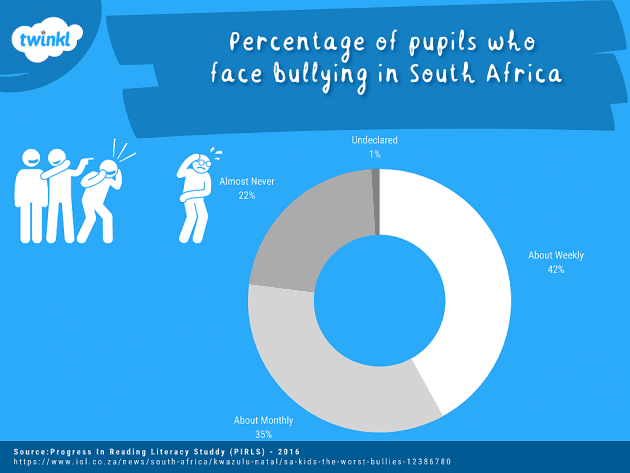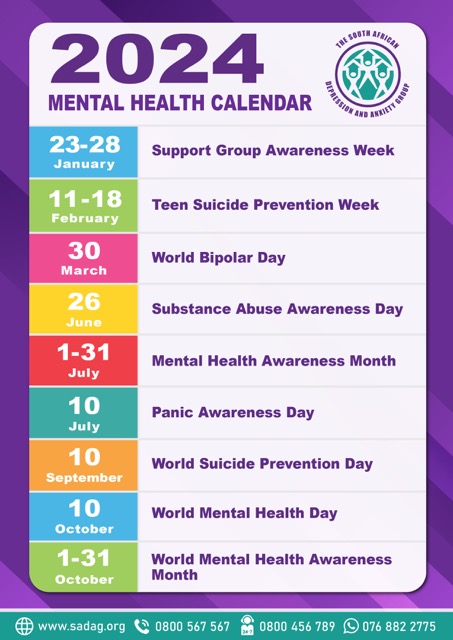By Jozef Raczka
Content Executive (twinkl)
We collaborated with some top organisations working to prevent bullying to bring you a range of advice for dealing with bullying both in-person and online.
What is Anti-Bullying Week?
From November 11th-15th, in South Africa, it is Anti-Bullying Week. With the aim of raising awareness of the risks of school bullying, cyberbullying and harassment in children and young people across South Africa, there are similar events happening across the world over the month of November. It aims to find ways to prevent this problem, which has become a terrible danger for children and young people today.
What is bullying?
It is important to discuss with children what bullying really is so that they can identify it if it occurs, either in class or in everyday life, and understand why it is wrong. Bullying is any deliberate behaviour that is done to hurt or upset someone over a period of time. As such, it can happen anywhere there are people, such as schools and workplaces. Bullying can be done by an individual or a group of people in many different ways. This includes verbal harassment, in which someone is hurt through petty words, insults, or offences.
Physical bullying occurs when bullies cause physical harm to another person. As a result, bullies can exert control over another individual and gain a sense of power. This type of bullying can range from pushing and shoving to kicking, slapping and punching. This makes it the easiest form of bullying to identify and also to deal with.
In contrast, cyberbullying is one of the most complicated forms of bullying to watch and prevent. When it occurs through the Internet, smartphones and social networks, bullies can remain anonymous, while victims can suffer in silence.
Cyber-bullying has no fixed location but can occur anywhere from school to a child's home. In a world where social media and the use of smartphones are increasing, protective measures against cyberbullying are especially important for the protection and well-being of children and adolescents.

As the chart above shows, in 2019-20, there were nine murders and 19 attempted murders associated with bullying in South Africa. Even before evaluating the assault statistics, this really illustrated the serious nature of this issue. This is not an issue that can simply be ignored and will go away, it is in need of intensive focus and work being done to help and help avoid future statistics being nearly as dramatic.
Clearly, bullying is a crucial issue that remains common and vitally important to address in schools. This is why we have decided to talk to recognised foundations throughout the country and across the world to gather the best advice on preventing and managing bullying in schools.
How to prevent & handle bullying
We have collaborated with some top organisations working to prevent bullying to bring you a range of advice for dealing with bullying both in-person and online.
Lauren Seager-Smith from Kidscape gave us some important advice:
-
“Have a shared definition of bullying – it is important that all members of the school community understand what you mean by bullying and the types of behaviour covered by the anti-bullying policy. Be mindful of parents and carers who may have English as an additional language, making sure that your response to bullying is fully inclusive.
-
Listen – make sure parents and carers know whom to contact if they have concerns. It helps to have a named lead. Consider an annual survey for children and parents to measure how safe children feel in school.
-
Focus on impact – while it is important to try and gather the facts there will be differences of opinion. Focus on the impact of the situation and how you can work together to make sure all children feel safe.
-
Response – keep a clear record of any incidents, and action taken. Make sure you follow up to ensure the bullying behaviour has stopped.
-
Learn – consider whether there is a wider culture that needs to be addressed. For example, if you are receiving complaints of sexist, racist or homophobic behaviour, consider a broader programme of education with the whole school community.
-
Remind – keep reinforcing your values and ethos as a community, refer to your agreed codes of conduct, and make the most of events such as term starts and Anti-Bullying Week to reinforce your approach to bullying prevention.”
Lauren also directed us towards their Anti-Bullying Week pack that is full of great tools for parents and carers.
Katy Clouds from Engage Education says that: “At Engage, every year we endeavour to raise awareness about Anti-Bullying Week. Tackling bullying in schools requires a team effort, including everyone from the senior leadership team to teaching assistants.
We’re taking this opportunity to let our teachers and support staff know how they can refine their approach to tackling bullying at school. This includes knowing what steps to take if a pupil is being bullied, ensuring your pupils know what to do if they are being bullied, and how to deal with anyone who bullies. You can read more in our Anti-Bullying Week article here.
Every school faces different challenges - there’s no one-size-fits-all approach to stamping out bullying. By building a robust anti-bullying strategy alongside teachers and parents, schools can be sure they are working towards a happier, more productive school day for every single pupil.”
Samantha Heald from Kidz 2 Kidz says that: “We encourage everyone to live by our Cool2bekind motto - Understanding that kindness is strength, rather than a weakness, it engenders respect for oneself and others. Not only does this discourage bullying behaviour, but it empowers children in situations of victimisation. Teaching a child that it is Cool2BeKind creates tidal waves of transformation.
If cyberbullying is taking place:
-
Screenshot the content
-
Remove yourself from the group or app that the cyberbullying is taking place on
-
Block the person or group of people who are cyberbullying
-
Do not respond
-
Do not engage in rage wars
-
Report the bullying and seek Adult support
-
Report to school principal if students involved, even if it is after school hours
-
If it does not stop, file a Harassment order at the local Magistrates court or contact a lawyer.”
Peter Moyes from Life Skills Education has given us his top tips for children to avoid bullying and cyberbullying:
-
“Talk about bullying/cyberbullying often and openly
-
Have an open-door policy for all
-
Have a simple set of rules or an acronym for staying safe
-
Encourage parental involvement
-
Identify sources of support with pupils
-
Advertise your policies – website social media etc
-
Specialist bullying/cyberbullying lead staff
-
Work with partners and governors
-
Make it visible - posters, displays etc
We would also encourage children to be a KIND FRIEND:
K – be kind, be nice
I – include everyone equally
N – never be nasty to others
D – respect others difference
F – friends look out for each other
R – report any concerns or worries
I – stay safe on the internet
E – everyone can be hurt by bullying and cyberbullying
N – no-one has to put up with it
D – do what you know is right”
Harassment can have devastating effects, not only on the individual who experiences it, but on the community at large where it occurs. In addition, in most cases where harassment occurs, the harasser himself is experiencing difficulties at home that cause him to misbehave, or he may even be being harassed.

Derek Peaple from the Safe To Net Foundation added that “Policies matter; culture counts. Pupils, parents and teachers must of course have a clear understanding of the policy and approach that a school will take when bullying – especially cyberbullying - is identified. But in having to apply for it, it’s often already too late.
At the heart of an effective anti-bullying strategy is therefore a community ethos and shared set of values which proactively seek to prevent harm from developing in the first place. A culture which promotes behaviours and learning that foster respect, online responsibility and kindness - and encourages open communication at every level: talk at home, at school and between the two.
Communication really is key. And it’s in this context that the pioneering SafeToNet safeguarding and wellbeing app offers a unique approach, with the potential to bring together home and school in a positive learning process that reduces risk and encourages shared understanding of digital wellbeing.
For the young person, the intelligent keyboard detects harmful messages before the damage is done, and also provides real-time advice on cyber-safety and wider emotional issues associated with potential bullying once they have been detected. For the parent, the app offers a powerful insight into their child’s digital world whilst respecting their privacy, therefore promoting positive discussions about their digital wellbeing. For the school, there is then a basis for dialogue with home about safe and appropriate online behaviours, self-regulation and maturity in relation to online communication and the wider use of social media.”
Linda from BulliesOut gave her top tips for dealing with both in-person and online bullying:
“I’m being bullied online – what can I do?
- As far as possible no reaction is the best reaction. A bully is looking for a reaction. Don’t give them one.
- Ensure your social media account settings are set to ‘friends only’ or ‘private’. 3. Screenshot any comments and report to the relevant social media platform as offensive content.
- Report any offensive photos or comments you see on your friends' newsfeeds/timelines as offensive content. Better to be the Upstander than the Bystander.
- Tell someone – a parent, a teacher – but someone who can provide you with some support.
- Don’t like or share a post even if it’s from a friend without reading it fully. The content could still be inappropriate and disrespectful and this will impact on your digital footprint.
I’m being bullied in person - what can I do?
- The most important thing to remember is that this is not your fault.
- No reaction is the best reaction. Bullies are actively seeking a reaction from you.
- Tell someone. Don’t be afraid to tell a teacher, a parent or someone who can support you.
- Write it down. Keep a diary of events to show when the bullying is taking place. Be the Upstander, not the Bystander. If you see someone being bullied offer them support. A little bit of kindness can go a long way.
- Don’t join in if someone is being bullied. That makes you a bully too.”
Geri from SupportLine directed us towards their advice on Bullying at School. You can find the full article from the above link but we wanted to focus on this passage from their advice for parents:
- If your child is being bullied he/she may be reluctant to tell you. Watch out for any signs of change of behaviour in your child - becoming withdrawn, depressed, not wanting to go to school, bed wetting, outbursts of anger, feeling ill etc. If you feel your child is being bullied then talk to them about school, are they making friends, is anything upsetting them, are they being bullied.
- If your child tells you they are being bullied please take it seriously - some parents don't and this can lead to your child feeling even more isolated and alone.
- Encourage your child to keep a diary of all incidents.
- Talk to your child about how to be assertive and the difference between assertiveness and aggression.
- Encourage your child to tell their teacher.
- Encourage your child to form friendships out of school.
- Give your child time and space to talk to you about how bullying is making him/her feel.
Zane from SADAG (South African Depression and Anxiety Group) directed us towards his guide to prevent bullying and cyberbullying. Within his guide he said: “The vast majority of bullying incidents, whether they happen in person or online, go unreported. This means that most bullying behaviours are never addressed and victims continue to suffer. Teachers and school administrators can help by keeping the communication lines open and letting students know that they if they are bullied or witness bullying, anyone on staff—from their classroom teacher and guidance counsellor to the school nurse or principal—is available to listen.
The only way to address bullying is to send out a clear message that the entire school community is ready and willing to listen.It may sound simple but promoting anti-bullying behaviours (e.g., affirming the actions of students who intervene when bullying is spotted in the schoolyard or anywhere else on or off school property, including on the Internet) and addressing bullying behaviours (e.g., asking students who engage in bullying to reflect on their behaviour and in severe cases, responding with disciplinary actions) are the two most important steps teachers and school administrators can take to prevent bullying. Of course, in order for these efforts to be effective, it is important for teachers and school administrators to work together to establish and implement consistent school policies.
Please note that Twinkl is not responsible for, nor necessarily endorses, any of the content or views shared on the external websites listed above, or by their operators.
Originally published - https://www.twinkl.co.za/blog/anti-bullying-week-ways-to-help-prevent-and-handle-bullying-in-schools
|
|


























